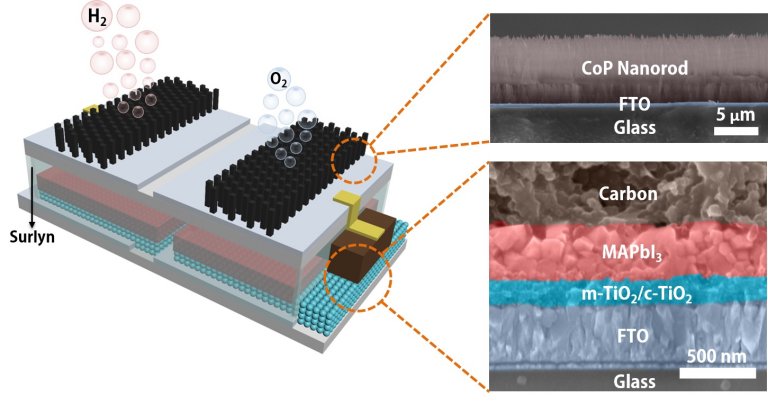TECH

Artificial leaf serves for continuous energy generation
Solar hydrogen
Jia Liang and colleagues at Rice University, USA, created an energy-efficient, low-cost cell that breaks down water molecules to produce hydrogen using only solar energy.
The technique itself is not new, with a wide field of research that goes by several names, such as artificial leaves, artificial photosynthesis, solar hydrogen, etc.
In this prototype, the team packed a layer of perovskite solar cells and the electrodes in a single module that, when submerged in water and placed in sunlight, produces hydrogen without any other input. The current flows to the catalysts that transform water into hydrogen and oxygen, with an efficiency of converting sunlight into hydrogen of 6.7%.
And that's where the news comes in.
"Jia replaced the more expensive components, such as platinum, in the perovskite solar cells, with alternatives like carbon," says Professor Jun Lou. "This reduces the barrier to entry for commercial adoption. Integrated devices like this are promising because they create a sustainable system. This does not require external power to keep the module working."
Perpetual power generation
Perovskites are semiconductor crystals with cubic structures, more efficient than silicon for collecting solar energy. The most efficient perovskite solar cells produced so far achieve an efficiency above 25% in converting solar energy into electricity, but the materials are expensive and tend to have low durability, being affected by humidity and heat.
Here comes the second novelty: The main component of this artificial leaf is not the perovskite itself, but the polymer that encapsulates it, protecting the module and allowing immersion in water for long periods.
"Others [researchers] have developed catalytic systems that connect the solar cell out of the water to electrodes immersed through wires," said Jia. "We simplified the system by encapsulating the perovskite layer with a Surlyn (polymer) film."
The operation was so good that the team is already thinking about integrating this solar hydrogen producing system with mechanisms that allow it to generate electricity continuously.
"With an intelligent system design, you can even create a self-sustaining loop," said Professor Lou. "Even when there is no sunlight, you can use the energy stored in the form of chemical fuel. You can put hydrogen and oxygen in separate tanks and incorporate another module, like a fuel cell, to turn those fuels back into electricity".
Bibliography:
A Low-Cost and High-Efficiency Integrated Device toward Solar-Driven Water Splitting
Authors: Jia Liang, Xiao Han, Yunxiu Qiu, Qiyi Fang, Boyu Zhang, Weipeng Wang, Jing Zhang, Pulickel M. Ajayan, Jun Lou

No comments:
Post a Comment